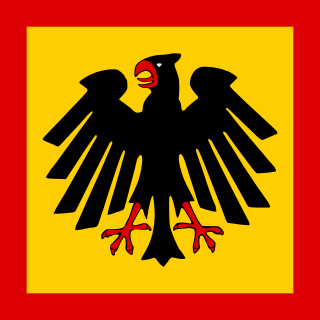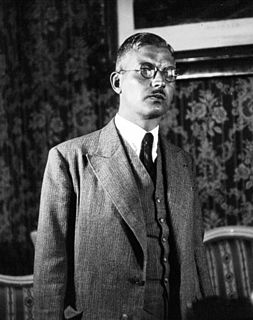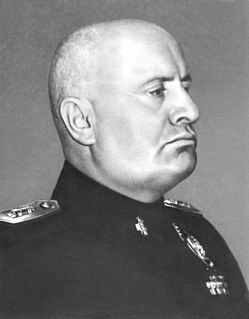
The Reichspräsident was the German head of state under the Weimar constitution, which was officially in force from 1919 to 1945. In English he was usually simply referred to as the President of Germany. The German title Reichspräsident literally means President of the Reich, the term Reich referring to the federal nation state established in 1871.

Kurt Alois Josef Johann Schuschnigg was an Austrofascist politician who was the Chancellor of the Federal State of Austria from the 1934 assassination of his predecessor Engelbert Dollfuss until the 1938 Anschluss with Nazi Germany. Although Schuschnigg accepted that Austria was a "German state" and that Austrians were Germans, he was strongly opposed to Hitler's ambitions to absorb Austria into the Third Reich and wished for it to remain independent.

The Sudeten German Party was created by Konrad Henlein under the name Sudetendeutsche Heimatfront on 1 October 1933, some months after the First Czechoslovak Republic had outlawed the German National Socialist Workers' Party. In April 1935, the party was renamed Sudetendeutsche Partei following a mandatory demand of the Czechoslovak government. The name was officially changed to Sudeten German and Carpathian German Party in November 1935.

Ostmark was the name used by Nazi propaganda from 1938 to 1942 to replace that of the formerly independent Federal State of Austria after the Anschluss with Nazi Germany.

A referendum on the treaty establishing a Constitution for Europe was held in Spain on 20 February 2005. The consultative referendum on ratification of the proposed Constitution of the European Union was approved by 81.8% of voters, although turnout was just 41.8%, the lowest since the end of the Franco era.
The Greater German People's Party was a German nationalist and national liberal political party during the First Republic of Austria, established in 1920.

Austria under National Socialism describes the period of Austrian history from 12 March 1938 when Austria was annexed by Nazi Germany until the end of World War II in 1945.

The Fatherland Front was the ruling political organisation of "Austrofascism". It claimed to be a nonpartisan movement, and aimed to unite all the people of Austria, overcoming political and social divisions. Established on 20 May 1933 by Christian Social Chancellor Engelbert Dollfuss as the only legally permitted party in the country, it was organised along the lines of Italian Fascism, except the Fatherland Front was fully aligned with the Catholic Church and did not advocate any racial ideology, as later Italian Fascism did. It advocated Austrian nationalism and independence from Germany on the basis of protecting Austria's Catholic religious identity from what they considered a Protestant-dominated German state.

General elections were held in Italy on 26 March 1934. Following a parliamentary reform enacted in 1928 by the Chamber of Deputies and Senate, the elections were held in the form of a referendum, with the Grand Council of the National Fascist Party, now an official state organ, allowed to compose a single party list to be either approved or rejected by the voters. The list put forward was ultimately approved by 99.84% of voters. The overwhelming majority provoked Benito Mussolini to dub the election the "second referendum of Fascism."

The States of the Weimar Republic were the first-level administrative divisions and constituent states of Germany during the Weimar Republic era. The states were established in 1918 following the German Revolution upon the conclusion of World War I, and based on the 21 constituent states of the German Empire that abolished their local monarchies. The new states continued as republics alongside the three pre-existing city-states within the new Weimar Republic, adopting the titles Freistaat or Volksstaat.
A referendum on withdrawing from the League of Nations was held in Germany on 12 November 1933 alongside Reichstag elections. The measure was approved by 95.1% of voters with a turnout of 96.3%. It was the first of a series of referendums held by the German cabinet under Chancellor Adolf Hitler, after the cabinet conferred upon itself the ability to hold referendums on 14 July 1933.

A referendum on merging the posts of Chancellor and President was held in Germany on 19 August 1934, after the death of President Paul von Hindenburg 17 days earlier. The German leadership sought to gain approval for Adolf Hitler's assumption of supreme power. The referendum was associated with widespread intimidation of voters, and Hitler used the resultant large "yes" vote to claim public support for his activities as the de facto head of state of Germany. In fact, he had assumed these offices and powers immediately upon von Hindenburg's death and used the referendum to legitimize this move, taking the title Führer und Reichskanzler.

Parliamentary elections were held in Germany on 29 March 1936. They took the form of a single-question referendum, asking voters whether they approved of the military occupation of the Rhineland and a single party list for the new Reichstag composed exclusively of Nazis and nominally independent "guests" of the party. Like previous elections in Nazi Germany, it was characterized by high turnout and a massively lopsided result, with an official 99.0% turnout. In a publicity stunt, a handful of voters were packed aboard the airships Graf Zeppelin and Hindenburg, which flew above the Rhineland as those aboard cast their ballots.

Parliamentary elections were held in Germany on 10 April 1938. They were the final elections to the Reichstag during Nazi rule and took the form of a single-question referendum asking whether voters approved of a single list of Nazis and pro-Nazi "guest" candidates for the 813-member Reichstag as well as the recent annexation of Austria. Turnout in the election was officially 99.5% with 98.9% voting "yes". In Austria official figures claimed 99.73% voted in favour with a turnout of 99.71%.
A referendum was held in Germany on 22 December 1929. It was a failed attempt to introduce a 'Law against the Enslavement of the German People'. The legislation, proposed by German nationalists, would formally renounce the Treaty of Versailles and make it a criminal offence for German officials to co-operate in the collecting of reparations. Although it was approved by 94.5% of those who voted, voter turnout was just 14.9%, well below the 50% necessary for it to pass.

The Reichstag, officially the Großdeutscher Reichstag after 1938, was the pseudo-Parliament of the Third Reich from 1933 to 1945. Following the Nazi seizure of power and the passing of the Enabling Act of 1933, it met only as a rubber stamp for the actions of Adolf Hitler's dictatorship — always by unanimous consent — and to listen to Hitler's speeches. In this purely ceremonial role, the Reichstag convened only 20 times, the last on 26 April 1942. The President of the Reichstag throughout this period was Hermann Göring.
Events from the year 1938 in Austria

"Austria – the Nazis' first victim" was a political slogan first used at the Moscow Conference in 1943 which went on to become the ideological basis for Austria and the national self-consciousness of Austrians during the periods of the allied occupation of 1945-1955 and the sovereign state of the Second Austrian Republic (1955–1980s). According to the interpretation of this slogan by the founders of the Second Austrian Republic, the Anschluss in 1938 was an act of military aggression by the Third Reich. Austrian statehood had been interrupted and therefore the newly revived Austria of 1945 could not and should not be responsible in any way for the Nazis' crimes. The "victim theory" formed by 1949 insisted that all the Austrians, including those who strongly supported Hitler, had been unwilling victims of a Nazi regime and therefore were not responsible for its crimes.
The Austrian Legion was a Nazi paramilitary group founded in 1933 from expatriate Austrian Nazis. Its members, mostly Sturmabteilung (SA), were trained in military camps in Bavaria, then armed in preparation for a potential invasion of Austria. Operating from 1933 to 1938, the Legion proved mostly ineffective and in some cases detrimental to Germany's interests in Austria.

























